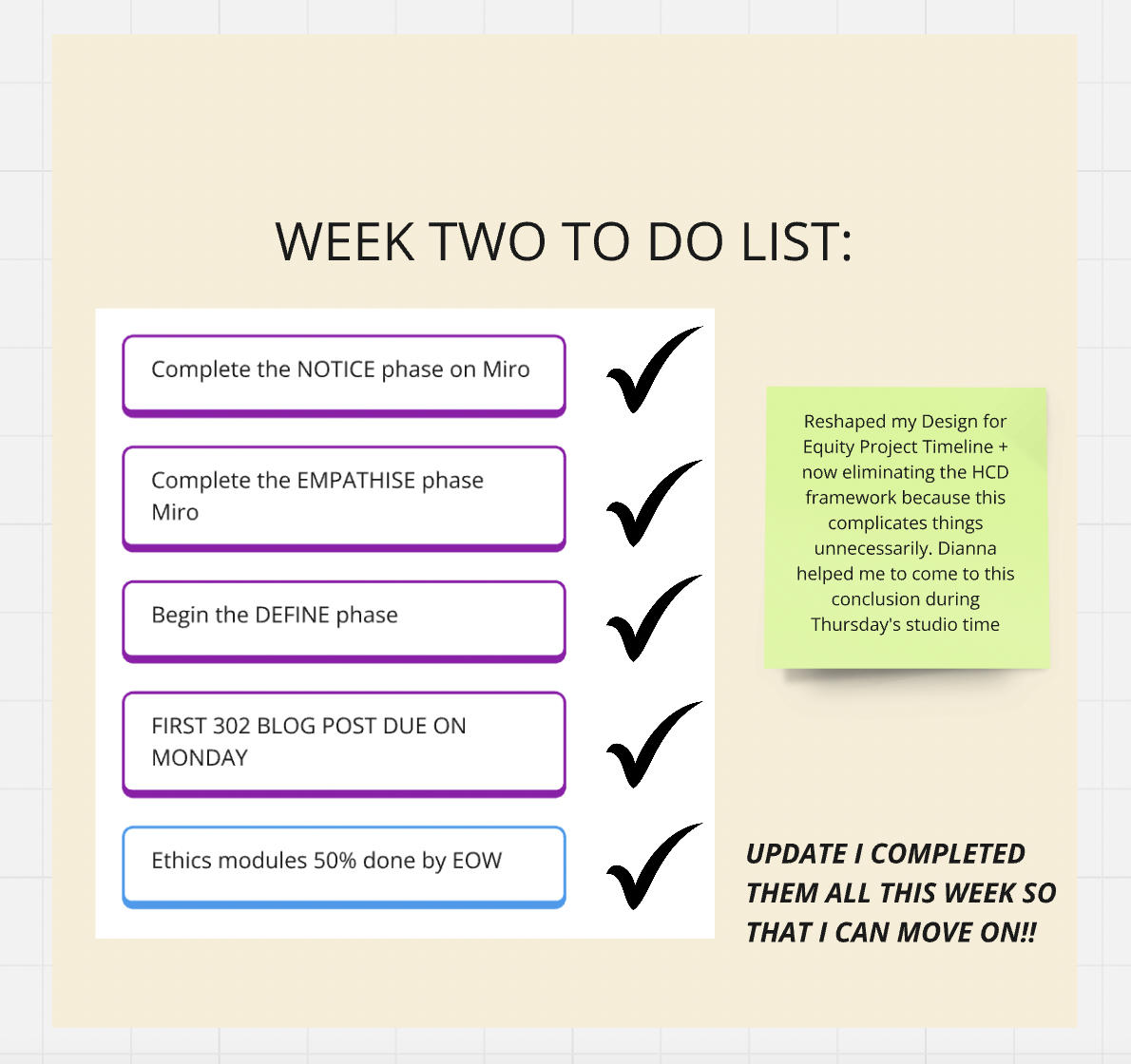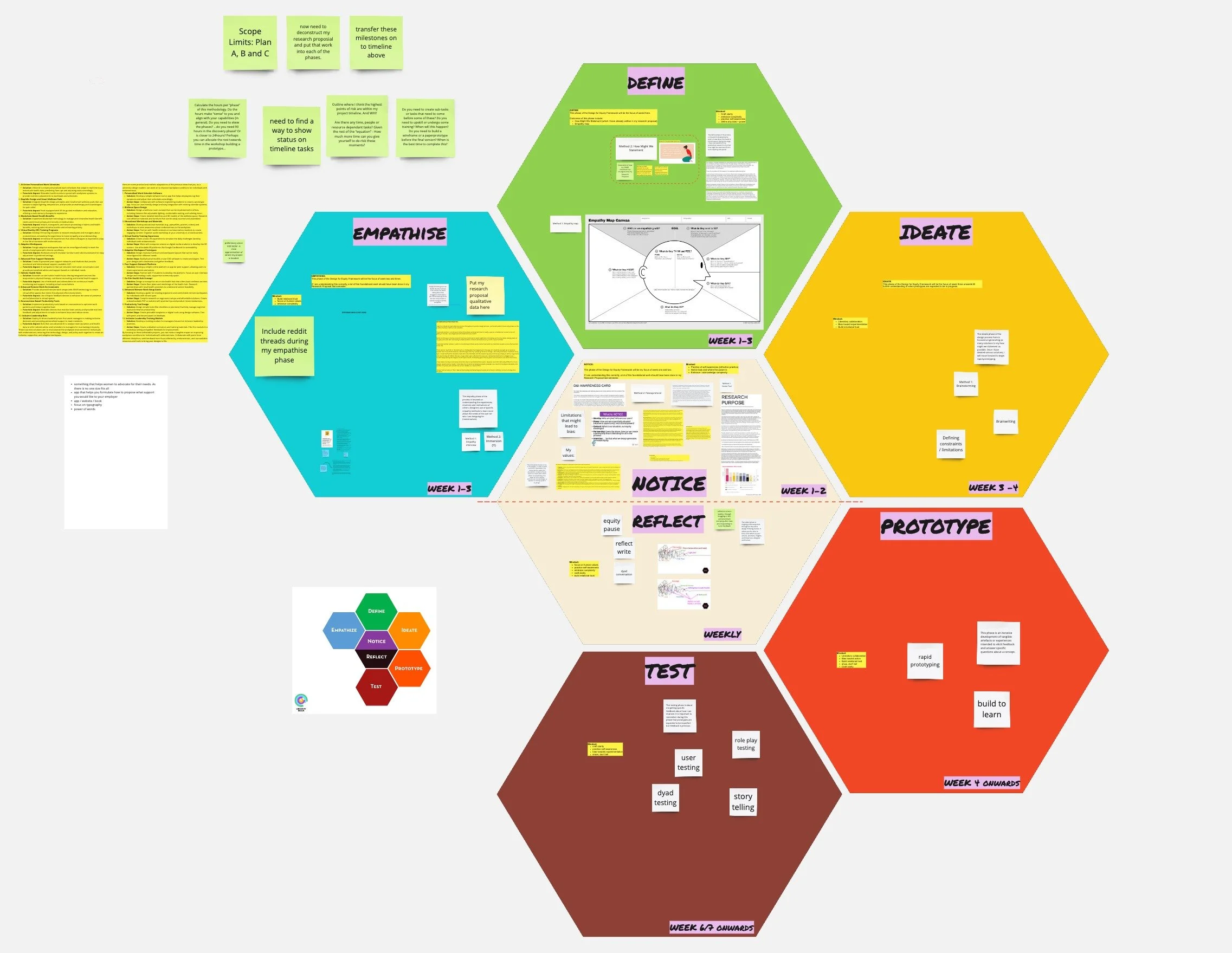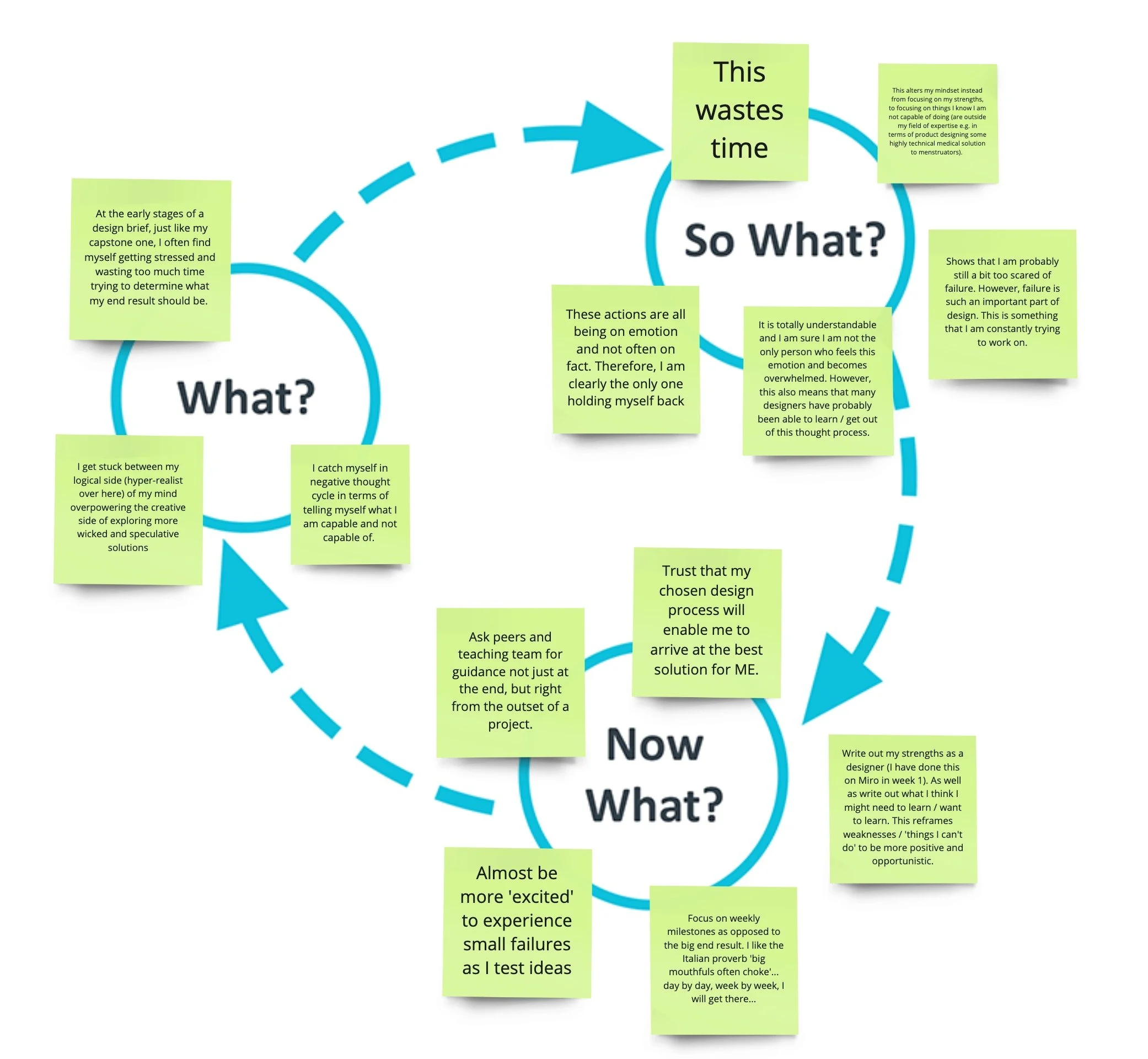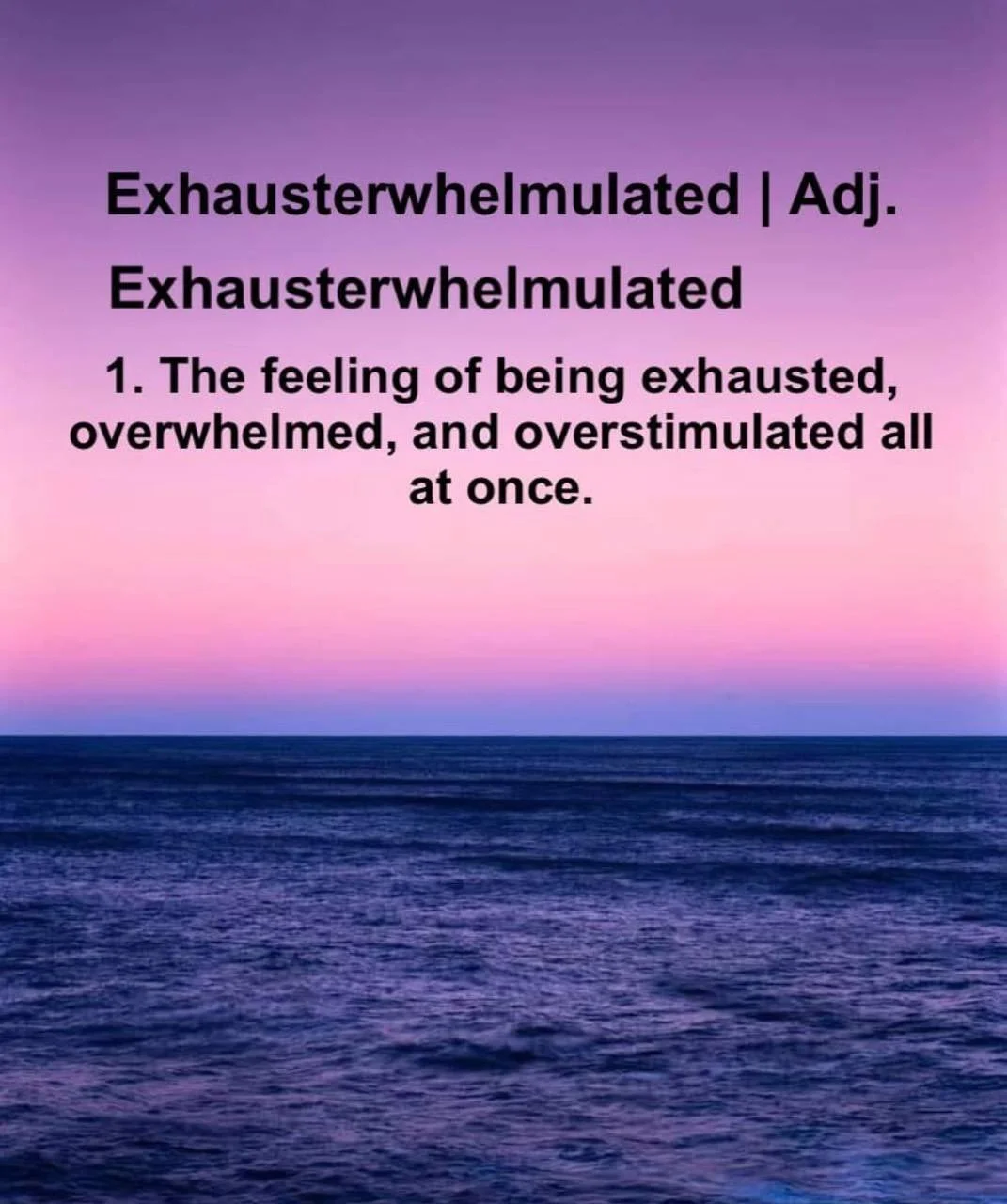Week 2
Current Status of the Project
This week, I focused primarily on completing all my ethics modules as well as filling out the ‘notice’, ‘empathise’ and ‘define’ stages of my Design for Equity framework on Miro. A lot of this work was transferring work that I had already done for my research proposal, over into the appropriate spot for it on my framework. This week felt like a big week of getting my ‘ducks in a row’…
Links:
This is an overview of my Week 2 Section on my 301 Miro. The rest of my work is either in my Design for Equity framework shown below, or over on my 302 Miro (linked) to my project timeline and brain dump.
This is the revised format of my Design for Equity Framework.
Tools and Technologies - In this project, I am using several tools and technologies, including:
Miro: I am using Miro to help me visualise not only my project timeline plan but also my Design for Equity framework.
Ethics Modules: Completing these modules was crucial for understanding the ethical considerations of my research. While they involved a lot of reading, they were incredibly useful, especially the module on confidentiality and anonymity. It made me look at personal information from a much more delicate perspective and opened my eyes to the complexity of storing and collecting data in today's world. The takeaways that I have learnt from these ethics modules I would consider to be very important ‘tools’ for me as a designer moving forward.
Design for Equity Framework: This design framework is central to my project, offering a structured approach to ensure inclusivity and equity in design. I spent last weekend mapping out how this framework can be broken down within a weekly project timeline, flagging relevant dates for both DES 301 and 302. This careful planning at the outset has provided strong foundations for efficient task management as well as helped me to mentally feel less daunted about hyper-fixating on the end result. However, I will mention that this design method does feel quite complex (and I am by no means an expert in it) so I am really trying to be careful and ask questions so that I know I am following the process in the most logical way for me possible. I am glad that I have chosen this framework because it builds in space for me to constantly bring in my own reflective practice. This is important to me, as I outlined in my research proposal that I suffer from lived experience with Endometriosis. Overall, the structured approach of the Design for Equity Framework helps me to ensure inclusivity and equity. It provides me with a clear roadmap and emphasises the importance of constantly revisiting and reflecting on key aspects.
Concept versus product: This is a constant thought I am having in terms of thinking about my strengths as a designer and which way I would like my project to lean towards. I know that my strengths as a designer (which I mapped out on Miro last week) are definitely more related to Adobe, branding, and concept design as opposed to e.g. physical product design. In this way, I am thinking I want to lean towards a design outcome that is more conceptual. However, I will flesh these thoughts out further next week and am conscious of not wanting to predetermine anything - as the real purpose of following any design process is to arrive at your best idea through the process (as opposed to picking an idea and changing your design process to fit that idea). Perhaps I am rambling here but I feel like it is important to speak this out at an early stage.
Current Challenges - At the moment, I am facing the following challenges:
Navigating Ethical Constraints: Understanding and adhering to the ethical constraints of the University has been a lot to wrap my head around but very necessary to understand so that I don’t make any unethical mistakes! The complexity of ethical considerations might slow down my progress and make things feel hard at times, but this is ultimately necessary for responsible and equitable design. Our class discussions this week clarified that my peers in DES 301 and experts are my primary focus group, which has helped narrow my focus and alleviate the stress of needing to reach out to a broader audience for surveys.
Refining Focus: Initially, I proposed three design methods, but I have now narrowed it down to one to align with the assignment rubric. This decision has made me feel less overwhelmed but also presents the challenge of ensuring I map the design process out correctly to cover all facets required within this single method.
Inclusive Design: To enhance inclusivity, I expanded my focus from just those with Endometriosis to all menstruators. This change aims to address equity more broadly but requires careful consideration of diverse perspectives and experiences. This is reflected in the development of my HMW statement which is now going to address not just those who are diagnosed with Endometriosis, but anyone suffering from cyclical menstrual pain (which will include those with PMDD, PCOS etc).
Strategies for Overcoming Challenges:
Navigating Ethical Constraints: Continue consulting with peers and instructors to ensure my approach aligns with ethical guidelines. I will use the ethical insights gained from the modules to handle personal data delicately and responsibly.
Refining Focus: Stay focused on the Design for Equity framework and iteratively refine it through feedback and reflection. By revisiting my research proposal and making necessary changes, I aim to move forward with my new HMW statement.
Inclusive Design: Incorporate a broader range of perspectives in my research to ensure my design is inclusive and equitable. This includes actively seeking diverse viewpoints and incorporating them into my design process. This will mean thinking about designing for all menstruators, not just those in office jobs when I am thinking about the workplace.
Holding myself accountable: I am really doing my best to use the weekly checklist and time planning to not only make the project seem less daunting but also to ensure that I am prioritising my time correctly.
Emotional Journey:
Reflecting on this week, I waver between feeling organised/on track and then feeling totally overwhelmed. However, I think that narrowing down my chosen design processes from three to one (this was ridiculous in hindsight) has made me feel infinitely less overwhelmed. Spending significant time last weekend with the information loaded on us in the first week was also beneficial. This week, I definitely found that understanding and navigating ethical constraints impacted my stress levels. However, having completed the ethics modules I now feel a lot more at peace with the expectations in terms of gathering data are for us. Each of these emotions and experiences has contributed to my growth as a designer.
Personal Reflections and Growth:
Reflecting on my journey, I've learned a lot about myself both as a designer and as a person. My positionality as a 23-year-old South African/New Zealand Pakeha woman has shaped my perspective. Recognising my privilege and access to resources, I aim to design inclusively and responsibly. I drafted a positionality statement and fleshed out my values as a designer, which has been helpful for the initial phases of the Design for Equity Framework (notice, empathise, and define). Going forward, I will continue to seek diverse perspectives to enhance my understanding and design practice. This experience has taught me the importance of grounding my work in ethical and local knowledge, and I am excited to apply these insights to future projects.
Reflector’s Toolkit: What? So what? Now what?
Things I Want to Do Next Week (fleshed out constantly on my Miro):
Precedent Studies: Find one or two precedent studies that strongly align with my refined HMW statement. Given the direction of my design process, finding these studies will be a useful exercise in developing my scope and vision for the next assignment.
Miro Setup: Focus on further setting up my Miro board for the upcoming DES 301 assignment. Doing this well will facilitate efficient project management and design process mapping.
Define: Get to a place that I am happy with on my Design for Equity Framework on Miro (in terms of filling out the phases). Once I have gotten to the stage where I have properly filled out the define stage, I will feel better placed to be able to feel like I am able to address the upcoming assignment rubric.
Summative Mental Health Check-in
Feeling Less Overwhelmed: I am feeling a lot less overwhelmed than last week. Asking questions during class and discussing ideas with peers has helped me feel more assured about my progress.
Waves of Emotion: I still experience waves of feeling organized and then overwhelmed about the final output. However, I trust that consistent effort will help me achieve my goals. Soundboarding my ideas with peers has been particularly helpful in managing these feelings. At this stage, I want to remember to focus on progress over perfection.
Over and out :)




